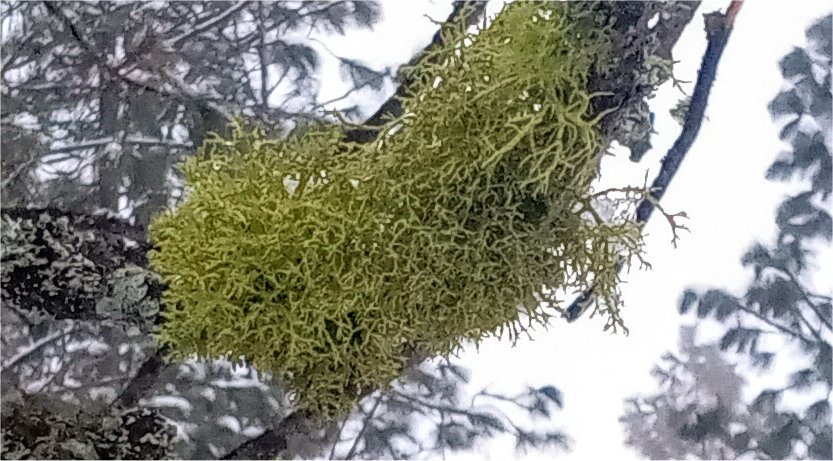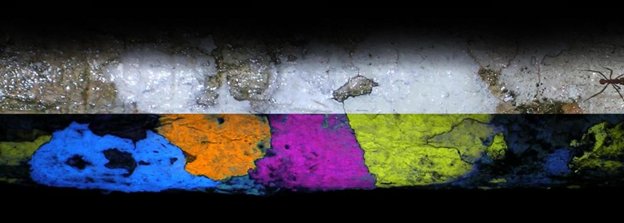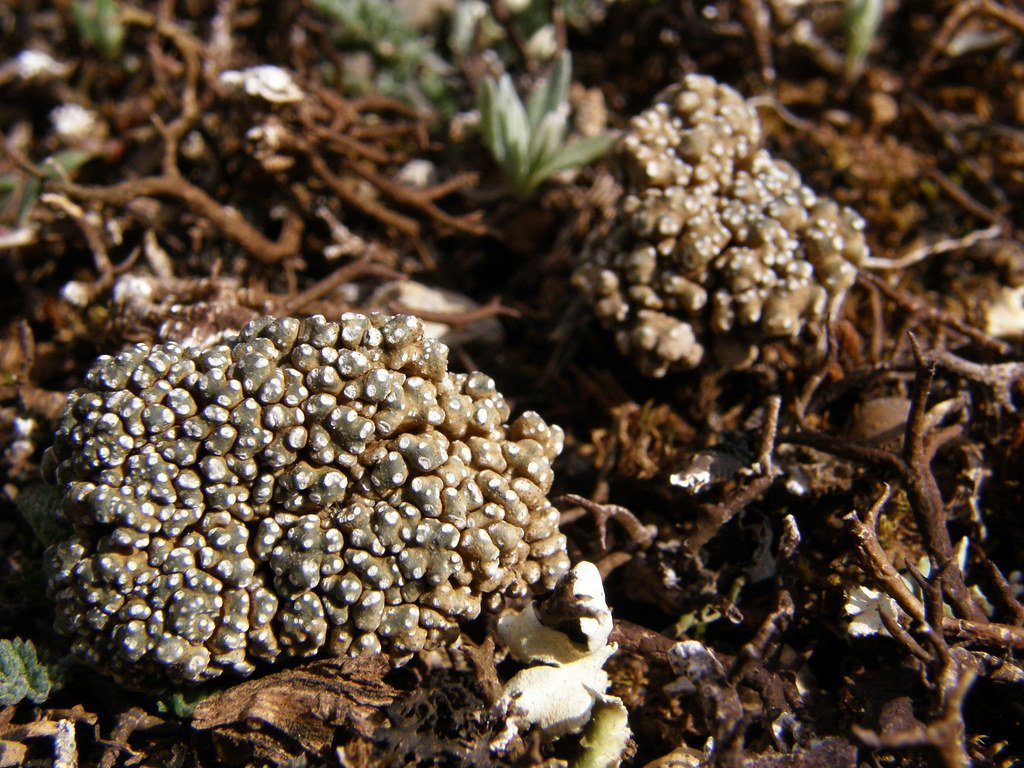
Wolf Lichen
Sometimes my wife, Cheryl, kids me about staring at the ground. Admittedly I do that often. Until a recent snowfall, we were experiencing an open winter. There was no snow on the ground but lots of other things were visible. One of the most prominent that caught my attention was a particular kind of lichen, very fuzzy and the color of the Seahawks’ neon jerseys. When much younger, that plant struck me as something that it would be easy to make miniature trees from for my HO train set. It still held together well even when dry.
Now I am associating its color with some seen on blacklight posters of the 60’s and 70’s. They would glow under ultraviolet (UV) light, I wondered what that lichen would look like under UV. (We will get to that later.) The main question about lichen is more like “What the heck is it?” It’s basically a fungus with a built-in food supply from algae. In fact, some forms host both green algae and blue-green algae. The fungus part needs the algae, but the algae can survive in water without the fungus.
I have some experience with algae. In college biology I followed up on a suggestion that algae grew quickly in water and could help the world food supply. I had also heard that adding carbon to the process might speed it up. This was wrong on many levels but nevertheless I concocted an experiment where I grew unicellular green algae in two carboys, the big glass bottles used to supply water for water coolers. One was left alone in the sun. The other was also in the sun but had carbon dioxide injected into it from a simple system that piped CO² off evaporating dry ice into the carboy. I ordered the green algae and set up the dry ice bubbling into just one carboy. A day or so later a loud “kaboom” was heard all over campus. Word got back to me that it was my algae experiment.
Behind the dorm, next to an adobe wall, I discovered the problem. Very cold CO² condenses water on a copper pipe. Very cold water, freezes into ice and seals the tube. A sealed tube doesn’t let evaporating CO² escape. Essentially, I had created a dry ice pipe bomb. That took a while to live down.
The algae growth went sideways too. When I looked at it under a microscope there were lots of living creatures in there moving around. None looked like the algae I started with. It turns out that millions of life forms float around in the air column and come alive when they find water. Looking for answers about what lichen eat and how do they reproduce, I found out that basically they eat air, especially moist air and they absorb many of those other things floating around in the air. That’s why this moist Fall-Winter had them expanding everywhere and falling to the ground. They can also extract minerals from rocks and probably tree bark.
Reproduction is a little trickier. Lichens do produce spores. But the spores only produce fungus, not lichen. They also produce soredia, a cluster of algae cells wrapped in fungus filaments. Even more straightforwardly, they make isidia, basically miniature lichen. Since lichen can dry up completely and survive until they get wet again, isidia are not hard to imagine. They can themselves be spread in the air column or be carried by insects, some of which dine on lichen.
Everything about lichens seems to be a little tricky. There are about 18,000 named species. But since many kinds of fungus seem to be able to form a symbiotic relationship with algae, there are potentially 250,000 combinations. Lichens produce over 700 organic chemical compounds. Some like Reindeer Moss, which is really a lichen, nourish reindeer and other arctic animals. Others are poisonous.
That neon lichen that first piqued my curiosity is called Wolf Lichen. It is said to have been used to poison wolves in Europe, which raises questions like “Why would wolves eat something poisonous?” One article noted that Wolf Lichen was mixed with ground glass and presumably some kind of meat to poison the wolves. Indigenous people ate certain kinds of lichen. Lichen can store vitamin D, that we usually get directly from sunlight, for use in the darker times of the year. Other uses include clothing, dye, and medicine.
A very common use of lichen comes from its diet of air. Lichen die in polluted air, a canary in the coal mine kind of “use”. In fact, the Forest Service tracks the lichen population on over 10,000 plots to monitor air pollution. Not only does what kills lichen make it interesting, it can live for decades, even centuries because of its ability to dry completely and rehydrate.
Getting back the original question about how lichen responds to ultraviolet light, I got out my handy-dandy 365 nanometer LED UV flashlight and started looking at the ground at night. Bam! There are an amazing number of things that light up in different colors at night under UV light. Many of them are probably lichen, but not the neon green Wolf Lichen. Not letting well-enough alone, I googled do lichen fluoresce? Yes!
Canada has a fascinating website, https://Nature.ca with pictures of fluorescent lichen. One, taken by Dr. Robert Lücking at Las Cruces Biological Station in Costa Rica, shows five different fluorescent colors next to each other on one branch. I wasn’t so lucky with Wolf Lichen, but love this picture.

Nature.CA features a lichen that grows there, Candy lichen (Icmadophila ericetorum). It is a “favourite” of many naturalists because it’s easy to recognize, with its pink fruiting bodies on a mint green crust, and its memorable alternate common name of fairy puke. It also glows under UV.

Aspicilia fruticulose, rim lichen, grows in Idaho among many places and holds a distinction not claimed by any other lichen. Samples of aspicilia fruticulosa from Spain survived 18 months attached to the outside of the International Space Station. Lichens can cope with radiation 12,000 times the lethal dose for humans and still carry on photosynthesizing. These properties prove the concept of Lithopanspermia, which postulates that life forms could have arrived on earth via rocks travelling through space. Move over cockroaches! There’s a new player in the game of cosmic survival.
